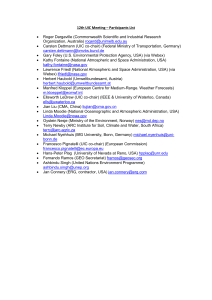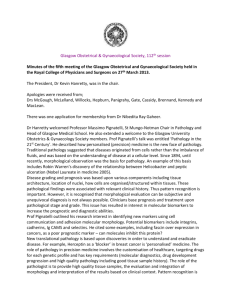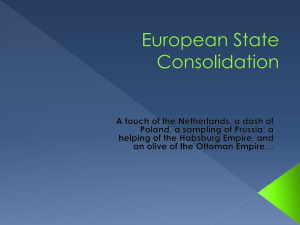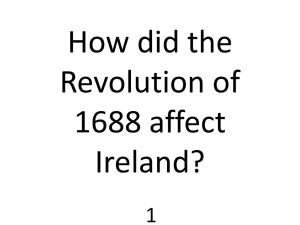Document 10466151
advertisement
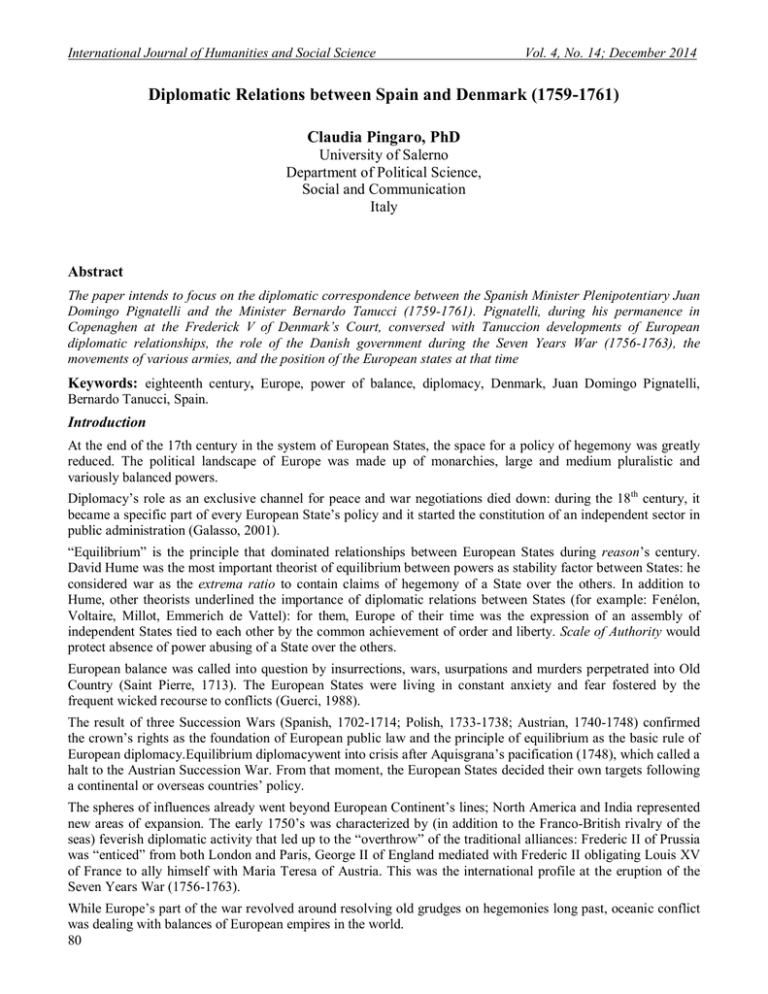
International Journal of Humanities and Social Science Vol. 4, No. 14; December 2014 Diplomatic Relations between Spain and Denmark (1759-1761) Claudia Pingaro, PhD University of Salerno Department of Political Science, Social and Communication Italy Abstract The paper intends to focus on the diplomatic correspondence between the Spanish Minister Plenipotentiary Juan Domingo Pignatelli and the Minister Bernardo Tanucci (1759-1761). Pignatelli, during his permanence in Copenaghen at the Frederick V of Denmark’s Court, conversed with Tanuccion developments of European diplomatic relationships, the role of the Danish government during the Seven Years War (1756-1763), the movements of various armies, and the position of the European states at that time Keywords: eighteenth century, Europe, power of balance, diplomacy, Denmark, Juan Domingo Pignatelli, Bernardo Tanucci, Spain. Introduction At the end of the 17th century in the system of European States, the space for a policy of hegemony was greatly reduced. The political landscape of Europe was made up of monarchies, large and medium pluralistic and variously balanced powers. Diplomacy’s role as an exclusive channel for peace and war negotiations died down: during the 18th century, it became a specific part of every European State’s policy and it started the constitution of an independent sector in public administration (Galasso, 2001). “Equilibrium” is the principle that dominated relationships between European States during reason’s century. David Hume was the most important theorist of equilibrium between powers as stability factor between States: he considered war as the extrema ratio to contain claims of hegemony of a State over the others. In addition to Hume, other theorists underlined the importance of diplomatic relations between States (for example: Fenélon, Voltaire, Millot, Emmerich de Vattel): for them, Europe of their time was the expression of an assembly of independent States tied to each other by the common achievement of order and liberty. Scale of Authority would protect absence of power abusing of a State over the others. European balance was called into question by insurrections, wars, usurpations and murders perpetrated into Old Country (Saint Pierre, 1713). The European States were living in constant anxiety and fear fostered by the frequent wicked recourse to conflicts (Guerci, 1988). The result of three Succession Wars (Spanish, 1702-1714; Polish, 1733-1738; Austrian, 1740-1748) confirmed the crown’s rights as the foundation of European public law and the principle of equilibrium as the basic rule of European diplomacy.Equilibrium diplomacywent into crisis after Aquisgrana’s pacification (1748), which called a halt to the Austrian Succession War. From that moment, the European States decided their own targets following a continental or overseas countries’ policy. The spheres of influences already went beyond European Continent’s lines; North America and India represented new areas of expansion. The early 1750’s was characterized by (in addition to the Franco-British rivalry of the seas) feverish diplomatic activity that led up to the “overthrow” of the traditional alliances: Frederic II of Prussia was “enticed” from both London and Paris, George II of England mediated with Frederic II obligating Louis XV of France to ally himself with Maria Teresa of Austria. This was the international profile at the eruption of the Seven Years War (1756-1763). While Europe’s part of the war revolved around resolving old grudges on hegemonies long past, oceanic conflict was dealing with balances of European empires in the world. 80 © Center for Promoting Ideas, USA www.ijhssnet.com France and England fought in two theatres very distant from each other and from Europe: India and America. It was essentially a mercantilist war to obtain parts of oceanic traffic: an almost-world war for the control of the largest importation flux areas; sugar, American coffee, tea, silk, and inexpensive Indian cotton (Viola, 2004). That war can be considered the first real “world” war, taking into consideration the involved states, the field of battle on which it occurred, and the consequences it generated on international political assets. Frederic II of Prussia confirmed his military abilities and, in spite of the outcome of battles, only the death of Tsarina Elizabeth and the accession of Tsar Peter III of Russia (early 1762) allowed to Prussia to obtain profits from peace of Hubertusburg, who in 1763 acknowledged the status quo ante. In the same year, the pacification between England and France led up to the defeat of the French Colonial Empire. The French colonies in both India (except Pondichéry and Mahé) and North America changed to English hands. England also acquired Florida from Spain, compensating the Spanish with Louisiana in the west. Martinique and Guadeloupe were returned to France from England. The Continental asset was confirmed by war’s result, but global balance was severely altered compared to the balance at the beginning of the 18th century: this situation just confirmed the supremacy of England in the world. The greatest colonial power, for territorial extension, remained the Spanish. The new de Bourbon dynasty regained strength and credibility in Europe by establishing its rulers on thrones of Naples and Parma. This research is founded on the analysis of diplomatic documents housed at the State Archive of Naples (Foreign Office). These documents regard the correspondence of Juan Domingo Pignatelli, Spanish extraordinary emissary of Ferdinand VI, and later of Charles III at Denmark Court. These diplomatic missives were sent to the Neapolitan minister of Foreign Affairs, Bernardo Tanucci. The examined documentation covers a period of about two years (1759 to 1761) and contains many accurate and meticulous facts concerning the Seven Years War and the court’s lifetime. 1.Juan Domingo Pignatelli in Denmark between 1759 and 1761 The diplomatic correspondence between Prince Juan Domingo Pignatelli and Tanucci was sent by privileged observatory, Frederic V of Denmark (1746-1766). Denmark’s neutrality kept the country from the cruel conflict fought in the rest of the world. Danish policy was inspired by reforms wanted by Frederic to prevent another dramatic war. Danish neutralism policy was the result of strategic choices wanted by most influential and closest to the king: Johann Hartwig Ernst Bernstorff of Hannover (from 1751 Minister of Foreign Affairs) and Adam Gottlob Moltke of Bregentved (Court Marshal). The commercial relationship between Danish Cour and Charles de Bourbon was ruled by the Trattatoperpetuo di Commercio, e Navigazione (Madrid, 1748). The contacts to close the pact began in 1740 – during the reign of Christian VI (1730 – 1756) – on the initiative of Danish government. The Trattatowas inspired by theories of new-mercantilism. It was made up of forty Articoliand it regulated accounts and navigation rules between the subjects of two Crowns (reciprocal respect, friendship obligations and benefits in economical exchanges). We can read in the Articolo II : traVassalli, Abitanti, e SudditidelleLoroMaestà vi saràliberocommerciotanto per terra, quanto per mare […] di manierache i Sudditi di SuaMaestàSicilianapossanoandare e trafficarenegliStati di S. M. Danese[…] e cosìreciprocamente i Sudditi di S. M. Danesepossonoandare a trafficare ne’ Regni di Napoli, e di Sicilia, come pure ne’ Presidj di Toscana. The signing of the Trattato was inspired by cultural currents of the time; the new mercantile theories used trade and economic growth to give affirmation to the power of the States. In the Kingdom of Naples (an independent entity under de Bourbon rule from 1734) Charles de Bourbon stimulated the debate on reformation and on the well-known models of European development by Southern intellectuals to consider a progressive policy in the South. Many issues relating to Neapolitan diplomatic relations were clarified in a valuable source, the Epistolario of Bernardo Tanucci. Appointed as Prime Minister of Naples at the time of the departure of Charles de Bourbon to Madrid, Tanucci’s Epistolario contains confidential diplomatic correspondence to Neapolitan representatives abroad. In particular it contains correspondence to Charles de Bourbon, who continued to have a strong decisionmaking presence on important policies of the Kingdom of Naples while he was abroad. 81 International Journal of Humanities and Social Science Vol. 4, No. 14; December 2014 Charles of Bourbon ascended to the throne under the name Charles III of Spain following the death of his halfbrother Ferdinand VI. He confirmed a diplomatic role to Juan Domingo Pignatelli, who became the representative of Spain at the Danish court. On October 20th of that year, Pignatelli made it known that he would mail his correspondence to Tanucci: quedoenterado de quees la voluntad del Rey […]que no haviendo en esta Capital Ministroalguno del rey de las dos Sicilias, me corresponda con el Secretario de Estado de Napoles, como lo hago con el de mi corte, dandotodaslasnoticiasquemerecenalgunaatencion, o quepuedeninteresar el servicio de ambasMagestades (State Archives of Naples, Foreign Office).He sent news from Vienna of militarymovements in Central Europe: losRussosse havianretirado a Fraustadtfrontera de Silesia y Polonia y queelrey de Prussia haviendodexadosu Exercitoparaobservarlos, se haviaido de su Persona al Exercito del Principe Henrique, que se hallava a Strehla quasi en friente del MariscalDaun, pues no distavanlosdosExercitos mas que de media legua. Los Suecosmantienensuquartel General a Pasewalk(State Archives of Naples, Foreign Office). In 1759, the Prussian Army of Frederic II was defeated twice: on July 28thin Zülichau (Newmark) by Russian General PëtrSoltykov and the on August 12thin Künersdorf (near Frankfurt) by both Russian and Austrian Armies. In this moment Frederic II lost one-third of his army on the battlefield and the control of Saxony. Juan Domingo Pignatelli was an influential interlocutor at the Danish court: he referred his news directly to Minister Bernstorff. Pignatelli’s worries about request of weapons from Morocco’s representative were quickly referred to theMinister with the following words:Ministro de estadosobreeste particular, representandole el grave perjuicioqueestegenero de regalospuedehacer a los vasallos del reymiesmo, y del rey de las dos Sicilias, me ha prometidoque se negarianabsolutamentelasmuniciones, y me hanaseguratoprocurarian con todos los esfuerzosimaginablesmantenerestemismoproposito con las de mas PotenciasBarberiscas, persuadiendolas de admitirregalos de generos y dinero en lugar de lasmuniciones (State Archives of Naples, Foreign Office). On November 27, 1759, Pignatelli informed Tanucci that he rejoiced at the news of His Majesty of Sicily’s ascent to the Spanish Throne as Charles III: en fecha de 23 Octubre, haviendoobtenidoayerunaAudiencia, la entregue en manos de S. M. D. acompañandola con todaslasexpresiones de la buenacorrespondencia y sincera Amistad quedesearíamantener S. M. S., me respondio en los mismosterminos, diciendome de asegurar a S. M. S. quecelebrava con todasveras la exaltacion de suMagestad al Trono de las dos Sicilias, y quesaviaquantoestuviese de su parte paraentretener la buenaamistad y union quereinava entre las dos Naciones (State Archives of Naples, Foreign Office). On November 11th, news from Copenaghen concerned the Danish royal family and the battlefield: adjuntaremito la respuesta del rey de Danimarca a la carta de notificacion de la exaltacion de suMagestad al Trono de las dos Sicilias; me la entregòayer el Ministro de Estado Baron de Bernstorff (State Archives of Naples, Foreign Office). Pignatelli sent word to Tanucciof the health improvements of Princess Louise of Denmark (daughter of Frederic V of Denmark by his first wife Louise of Hannover, dec.1751) who was afflicted with smallpox. The years 1758-1759 proved to be decisive for the course of conflict: England took control of the seas and Frederick II of Prussia kept his hold over French-Austrian troops. In April 1758, following Russia's invasion of East Prussia, England and Prussia secured a new treaty: Frederick II agreed to pay an annual duty and give a contingent to England. Shortly after, Prussia unleashed an offensive movement in Moravia, putting Olomouc under siege. The imperial troops soon forced Prussia to retreat. On November 20. 1759, Frederick II of Prussia was again defeated near Maxen in Saxony. When Pignatelli was informed of the defeat, he sent word to Tanucci regarding the outcome of the war and the superiority of the Austrian and Swedish:nodirè nadaa V. S. de lasventajas del MariscalDaun, pueslashavràsavido con anticipacionpor el Ministro de Vienna, añadirèsolamentequehaviendollamadoasì el rey de Prussia, des pues de este mal sucesolastropasqueestavan en Pomerania, se discurreque los Suecospodrantomar sus quarteles de Ynvierno en el pays enemigo(State Archives of Naples, Foreign Office). 82 © Center for Promoting Ideas, USA www.ijhssnet.com News from Copenhagen continued to contain military concerns. The movements of the Austrians and the Prussians and the losses Frederick II underwentwere of particularinterest: Veo con gran satisfaccion – Pignatelli wrote to Tanucci – […] que Su Magestad Siciliana me hace la honra de darse por satisfecho del zelo con que procuro comunicar laspocasnoticiasquellegansiempreatrasadas a este pays por la larga distancia, pero yaque Su Magestad se dignacontentarse, proseguirè y para señal de mi obediencia, dirè, queel correo de ayer ha traydo la confirmacion de un choquemui vivo qua ha havidoel dia 11 de este mes a Marienberg, entre un Cuerpo Austriaco, mandado por elCondeEsterhazy, y otro Prussiano, mandado por elTeniente General Kalcstein, que ha quedadoprisionero, con elmayor General Corbitz y tresmilhombres de su tropa, haviendoperdido mas de 90 cañones, muchas Banderas, estandartes y otroPertrechos de guerra (State Archives of Naples, Foreign Office). In December 1759, Juan Domingo Pignatelli alsowrote to Tanucci about the dreadcaused by a major earthquake in the Danish capital: la noche del dia 21 al 22 de este mes, a eso de lasDoce y tresquartos, se ha sentidoaqui un terremoto, queaunque ha sido bastantemente violento, no ha causadoningunadesgracia(State Archives of Naples, Foreign Office). Thanks to the historical erudite promoted by Charles de Bourbon in Naples, Pignatelli received two volumes on the excavations of Herculaneum to give to the sovereign Danes. This gift brought awareness to the Danish court of the archaeological excavations and artistic beauty being promoted by the de Bourbon government. Examination of the correspondence suggests that Pignatelli set the tone. He was careful to send secure communication on the war, Danish court life, and the everyday life of the royal family. Juan Domingo Pignatelli was privileged in that the echoes of battle resounded far from his place of observation. News of victories and defeats circulated, as all waited to see which policy framework would be instated in Europe once the conflict ended. In 1760 Austria and Russia signed a treaty to continue the war against Prussia. Austria tried to reconquer Silesia by starkly defeating Frederick II several times. The Prussian army lost many men, but they succeeded in regaining all Saxony (with the exception of Dresda). Frederick V was concerned by the evolution of the war and, despite Danish neutrality, he continued to upkeep the condition of his army. In a letter dated July 5th 1760, Pignatelli reported to Tanucci that he had followed Frederick V in Holstein paraacompañar S. M. D. en la revistaque ha echo de sus tropas (State Archives of Naples, Foreign Office) On this occasion, the ambassador had the opportunity to see first hand the state of the Danish army (at rest). He reported with great detail: three different encampments, thirty-two battalions, forty-eight squadrons, and that all were well organised, precise and rapid (State Archives of Naples, Foreign Office). The Danish sovereign was very attentive to the state of the cavalry keeping it well equipped with men and horses. On October 20, 1760 Pignatelli conveyed to Tanucci his grief for the death of Spanish Queen Maria Amalia - on September 27- who had continuously supported Spain’s neutrality at the time. From Copenhagen, on November 22nd, Pignatelli wrote of a battle that took place near Torgau (North Saxony) on November 3rd: the conflict was decisive and it allowed Frederick II of Prussia to reconquer most of Saxony. Juan Domingo Pignatelli also described the losses suffered by of Marshall Daun (Earl Leopold Josef Daun, head of the Austrian troops) and the retreat of the Russian and Swedish armies (State Archives of Naples, Foreign Office). In October, Russian and Swedish troops entered and sacked Berlin, abandoning the city upon the arrival of Frederick II’s army. 2. Changes in the International Framework In 1761, the international framework changed profoundly, becoming increasingly complicated for a multitude of reasons. The fall of Pitt in England for George III’s ascent to the throne (1760) translated to England’s gradual withdrawal from the war, Spain’s entry into the war, and proved the tactical military superiority of Frederick II of Prussia and his officers. In 1760, France and England had already begun peace negotiations. The new international environment affected Pignatelli’s diplomatic correspondence of October 1761. On the August 15, 1761, Charles III of Spain entered into the third Pacte de Famille with France (TéIlezAlarcia, 2010). This agreement bound Spain to the France of Louis XV, with their descendants and successors. Spain and France pledged to lend mutual aid in the event of a military attack. Charles III was aware that his army was unprepared when in December of 1761 Britain declared war on Spain. Spain was victorious, and gained occupation of the former Portuguese Colonia de Sacramento on the east bank of Rio de la Plata. France suffered defeats, leaving Spain to undertake peace negotiations. 83 International Journal of Humanities and Social Science Vol. 4, No. 14; December 2014 This conflict changed Pignatelli’s outlook from Copenhagen; he gave greater attention to the armies involved and their military strategies with increased information on the movements of Prussia’s army. On October 17, 1761, Pignatelli wrote of a low blow suffered by Frederick II - momentarily away with part of his army - the night of September 30, 1761 in the Prussian military camp in Scheveidnitz (Southwestern Poland, lower Silesia). On that night, Austrian General Loudon freed three thousand imprisoned soldiers and stole two hundred pieces of artillery, food, and ammunition from the camp. The Austrian raid affected Frederick II so deeply that se ha de considerer estaempresacomouna de las mas determinadas y osadasque se puedaexecutar (State Archives of Naples, Foreign Office). The commitment of the Minister Plenipotentiary, his devotion to duty and loyalty to Charles III and to minister Tanucci granted the diplomat a promotion to new offices (General Lieutenant on April 3, 1763; Minister Plenipotentiary in Parma on July 30, 1763), after the Seven Years’ War finished. Pignatelli’s experience in Denmark - a country that was able to keep its neutrality during the war - was one of tranquillity. He was pleased living there for five years, he affirmed: celebro con todasveras la quietudquegozaesta Capital y todo el Reyno(State Archives of Naples, Foreign Office). Pigantelli departed Copenhagen for his new assignment on November 28. He arrived in Paris on February 28, 1764 tired and sick. On August 8th, he arrived in Parma where he died in December of 1765 (Letters Tanucci, 2000). His sickness was probably due to the difficulties he encountered living in the Danish Capital: the country was not at all hospitable during the long winters, and the climate was very different from that of the Mediterranean. Pignatelli paid for these consequences. Conclusions In 1759 Charles de Bourbon ascended to the throne of Spain and continued a policy of diplomatic relations with Denmark. Juan Domingo Pignatelli, minister plenipotentiary sent by King Charles III to Denmark during the Seven Years’ War, had the opportunity to observe and discuss the goings on of European battlefields. The peaceful diplomatic tones of Pignatelli’s correspondence contrasted with the concrete situation that he lived in day by day. Denmark’s neutrality allowed Pignatelli distance from the dangers of war. During his years at the Danish Court, Pignatelli had a great understanding of the mechanisms of government that sheltered him. He recognized the role of Ministers Bernstorff and Moltke in decision-making and learnt crucial information on the fate of the armies involved in the war, thanks to his “privileged” viewpoint. He also had an eminent role at the Danish court and his voice was heard by the Danish government in delicate situations involving internal politics. Archival Sources State Archives of Naples Foreign Office, Correspondence with the minister of the court of Spain in Denmark (1740-1761), b. 260, I. 84 © Center for Promoting Ideas, USA www.ijhssnet.com References Ancillon J. P. F. (1804-1806). Darstellung der wichtigstenVeränderungenimStaatensysteme von Europa seitdemEnde des fünfzehntenJahrhunderts. Berlin: Quien. Anderson M. S. (1993). The Rise of Modern Diplomacy 1450-1919. New York: Routledge. Anderson M. S. (2000, fourth ed.).Europe in the Eighteenth Century 1713-1789. New York: Routledge. Bély L. (2007). Les relations internationales en Europe, XVIIe-XVIIIe siècles. Paris: PUF. Caridi G. (2014). Carlo III. Un grande re riformatore a Napoli e in Spagna. Roma: Salerno Editrice. Castel de Saint-Pierre C. I. (1714). A Project for Settling an Everlasting Peace in Europe. First proposed by Henry IV. of France, and approved of by Queen Elizabeth, and most of the then Princes of Europe, and now discussed at large, and made practicable by the Abbot St. Pierre, of the French Academy. London: J. W. and sold. DomínguezOrtiz A. (1988). Carlos III y la España de la Ilustración. Madrid: Alianza. Doyle W. (edited by) (2012). The Oxford handbook of the AncienRégime. Oxford: University Press. Galasso G. (2001). Storiad’Europa. Bari-Roma: Laterza. Guerci L. (1988). L’Europa del Settecento. Permanenze e mutamenti. Torino: Utet. Hélie J. (2008). Les relations internationals dansl’Europemoderne, 1453-1789. Paris: Armand Colin. Hull A. H. (1981). Charles III and the revival of Spain. Washington: University Press. Kahle L. M. (1744). La Balance de l’Europe consideréecomme la Régle de la Paix et de la guerre. BerlinGottingen: Schmid. Mafrici M. (1998). Il re dellesperanze. Carlo di Borbone da Madrid a Napoli. Napoli: EdizioniScientificheItaliane. Maiorini M. G. (edited by)(2000). Bernardo Tanucci, Epistolario XVI, 1765-1766. Napoli: SocietàNapoletana di Storia Patria. Maiorini M. G. (2001). I Danesi a Napoli nelSettecento. Il corpodiplomaticoattraverso i documentidell’Archivio di Stato di Napoli. in «AnalectaRomana. InstitutiDanici». Roma: «L’Erma» di Bretschneider,pp. 125-133. McKay D. – Scott H.(2014). The Rise of the Great Powers, 1648-1815.New York: Routledge. Migliorini A. V. (1984). Diplomazia e culturanelSettecento. EchiitalianidellaguerradeiSetteanni. Pisa: ETS. Ozanam D. (1998). Les diplomats espagnols duXVIIIesiècle: introduction et repertoire biographique (1700-1808). Madrid: Casa de Velázquez. PalacioAtard V. (1945). ElTercerPacto de Familia. Madrid: CSIC. Scott H. – Simms B. (edited by) (2007). Cultures of power in Europe during the long Eighteenth Century. New York: University Press. Scott. H. (2005). The Birth of a Great Power Sistem, 1740-1815. New York: Routledge. TéllezAlarcia D. (2012). ElMinisterioWall. La «Españadiscreta» del «ministroolvidado». Madrid: Pons. Viola P. (2004). L’Europamoderna. Storia di un’identità. Torino: Einaudi. Winding K. (1997). StoriadellaDanimarca. Breveprofilo. Pisa-Roma: IstitutiEditoriali e PoligraficiInternazionali. Wilson P. H. (edited by). (2008).A Companion to Eighteenth-Century Europe. Oxford: Blackwell. 85


